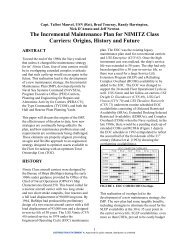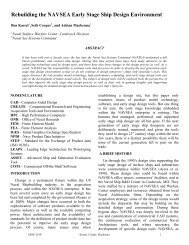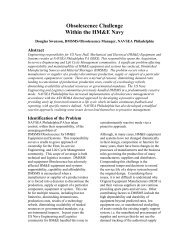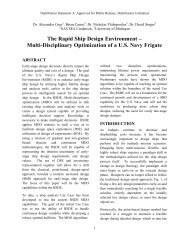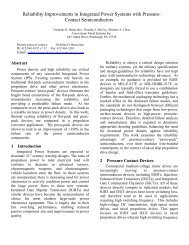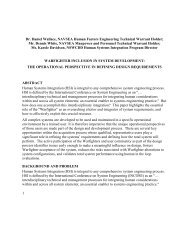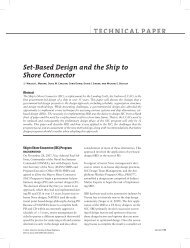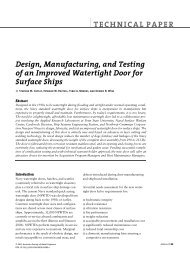The Wreck of DKM Bismarck − A Marine Forensics Analysis 1 The ...
The Wreck of DKM Bismarck − A Marine Forensics Analysis 1 The ...
The Wreck of DKM Bismarck − A Marine Forensics Analysis 1 The ...
You also want an ePaper? Increase the reach of your titles
YUMPU automatically turns print PDFs into web optimized ePapers that Google loves.
<strong>The</strong> <strong>Wreck</strong> <strong>of</strong> <strong>DKM</strong> <strong>Bismarck</strong> <strong>−</strong> A <strong>Marine</strong> <strong>Forensics</strong> <strong>Analysis</strong><br />
According to survivors, large cracks appeared in the welded seams in the outboard<br />
strakes <strong>of</strong> the main transverse bulkhead, which was also the forward boundary <strong>of</strong> Port Boiler<br />
Room No. 2 in Compartment XIII. Seawater seeped through these cracks and caused gradual<br />
flooding <strong>of</strong> this boiler room. A damage-control team attempted to seal <strong>of</strong>f these leaks with<br />
hammocks, but their efforts only slowed the seepage. <strong>The</strong> boiler room was back in operation for<br />
a short time. Boiler III was lighted, while Boiler IV was salt-contaminated and had to be shut<br />
down because there was a real danger <strong>of</strong> saltwater intrusion into the feed water system. By midafternoon,<br />
Boiler III also had to be shut down and the space was evacuated. Fuel from the<br />
damaged wing tanks in Compartment XIV was leaking into the sea.<br />
Soon after the action with Prince <strong>of</strong> Wales ended, a damage-control team attempted to<br />
seal <strong>of</strong>f the leaks in the 45-mm torpedo bulkhead on the portside in Compartment XIV with<br />
hammocks and mating, but their efforts only slowed the seepage into the boiler room. Eventually<br />
the boiler room was evacuated after the water became chest deep.<br />
Steam from other boilers was rerouted to the turbine in the port engine room. Splinters<br />
from the exploding shell also severed a main steam line in the No. 4 Turbo-Generator Room,<br />
scalding five <strong>of</strong> its occupants and necessitating the shutdown <strong>of</strong> the generators. <strong>The</strong> Turbo-<br />
Generator Room also flooded 12 . <strong>The</strong> loss <strong>of</strong> this electrical generating station was not serious,<br />
because the power supply <strong>of</strong> German battleships was so conceived that either the forward or the<br />
after station could supply the battle circuit load individually (i.e., the ship had 100% reserve<br />
battle load power).<br />
<strong>The</strong> bow flooding, coupled with the displacement <strong>of</strong> fuel oil in Compartment XIV and<br />
subsequent flooding <strong>of</strong> spaces there, caused the battleship to trim 1.5 meters by the bow, with a<br />
three-degree list to port <strong>−</strong> not nine degrees previously estimated. <strong>The</strong>se hits came around 0605<br />
(after Hood had sunk). <strong>The</strong> combination <strong>of</strong> trim and list caused the starboard propeller blades to<br />
break the water surface.<br />
Soon after the action with Prince <strong>of</strong> Wales ended, a damage-control team attempted to<br />
seal <strong>of</strong>f the leaks in the 45-mm torpedo bulkhead on the portside in Compartment XIV with<br />
hammocks and mating, but their efforts only slowed the seepage into the boiler room. Eventually<br />
the water was chest deep. <strong>The</strong>re was a real danger <strong>of</strong> saltwater intrusion into the feed water<br />
system. <strong>The</strong> crew managed to get Port Boiler Room No. 2 temporarily back in operation. Boiler<br />
III was back in service, although while Boiler IV was salt contaminated and had to be shut down.<br />
By mid-afternoon, however, Boiler III also had to be shut down and the boiler room was<br />
evacuated. Shell splinters also passed into double bottom tanks and wing fuel bunkers, causing<br />
the eventual flooding <strong>of</strong> that tankage and contaminating the fuel.<br />
<strong>The</strong>se reserve fuel tanks were intended for <strong>Bismarck</strong>’s consorts. <strong>The</strong> pump room for<br />
them was located outside the armored citadel. In an emergency, <strong>of</strong> course, this fuel could have<br />
been used by the battleship. To retrieve the oil in the reserve oil tanks, the <strong>Bismarck</strong>’s damage<br />
control team devised a plan to run a refueling hose over the main deck to the forward tanks, so<br />
the problem was isolation, not rupture <strong>of</strong> these tanks. Some <strong>of</strong> the reserve oil tanks could have<br />
been holed by fragments caused by this hit in the bow. Fuel leaking into the sea would have<br />
flowed along the side <strong>of</strong> the ship, being mixed by the turbulence in the wake, convincing<br />
observers aboard Prinz Eugen that there was oil on both sides <strong>of</strong> <strong>Bismarck</strong>'s wake.<br />
12 Midshipman Hans-Georg Stiegler, a naval constructor in training, was assigned to the electrical shop.<br />
He recalled that this compartment was successfully dewatered the next day.<br />
10



